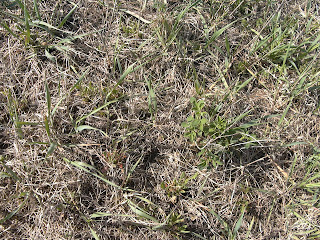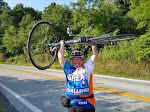This post is going to be about as exciting as dirt. Well, even if it's not exciting, it's still going to be about dirt. Well, actually, about soil. We visited the farm this weekend and as you can see, there has been enough rain and snow melt this year to overfill our pond (fondly called Lake Catherine) beyond the normal banks. The ducks are loving all the grassy area that is underwater. Even with all the rain, though, the field where we planted alfalfa, timothy and clover last year still is not green.  Perhaps you can see that the field is roughly divided into three areas - the area along the road that is gently sloping (toward the right side of the photo), the area where I am standing that is almost completely barren except for weeds and moss, and a third area bordering the creek, at the bottom of the hill (toward the left side of the photo). We planted the entire field using the same seed and the same methods. I believe what happened is that on the top of the hill, without a lot of organic matter in the soil, the wind and rain has washed away any topsoil there might have been. What is left is a sandy, desert-like area.
Perhaps you can see that the field is roughly divided into three areas - the area along the road that is gently sloping (toward the right side of the photo), the area where I am standing that is almost completely barren except for weeds and moss, and a third area bordering the creek, at the bottom of the hill (toward the left side of the photo). We planted the entire field using the same seed and the same methods. I believe what happened is that on the top of the hill, without a lot of organic matter in the soil, the wind and rain has washed away any topsoil there might have been. What is left is a sandy, desert-like area.  I did spot a few red clover and alalfa plants in this area, they are quite spread out, however. We are hoping that they self-seed and their roots will stabilize the soil, and add organic matter. It may not be apparent from this photo, but if you look, there is at least one clover plant here. This is encouraging. A few feet farther away is another spot where you can see nothing at all is growing - it really looks like a desert. Hopefully the photo shows the sand and rock.
I did spot a few red clover and alalfa plants in this area, they are quite spread out, however. We are hoping that they self-seed and their roots will stabilize the soil, and add organic matter. It may not be apparent from this photo, but if you look, there is at least one clover plant here. This is encouraging. A few feet farther away is another spot where you can see nothing at all is growing - it really looks like a desert. Hopefully the photo shows the sand and rock.  DH suggested that we ask the dairy farmer a few miles down the road to come and knife in some of his excess organic material. I think that would possibly be a great idea. Probably he is not an organic dairy farmer, but if your soil won't even grow weeds, you need to do something kind of extreme. I haven't formally studied the geology of western Michigan, but have visited the beach at Muskegon and seen the signs in the yards of the people who live there - FREE SAND! We are at least 30 miles east of the beach, but over the millenia, I guess the sand has blown away from the beach (unless the coastline of Lake Michigan has shifted!) The deer leave their footprints in the soft sand.
DH suggested that we ask the dairy farmer a few miles down the road to come and knife in some of his excess organic material. I think that would possibly be a great idea. Probably he is not an organic dairy farmer, but if your soil won't even grow weeds, you need to do something kind of extreme. I haven't formally studied the geology of western Michigan, but have visited the beach at Muskegon and seen the signs in the yards of the people who live there - FREE SAND! We are at least 30 miles east of the beach, but over the millenia, I guess the sand has blown away from the beach (unless the coastline of Lake Michigan has shifted!) The deer leave their footprints in the soft sand.  They are also making a trail across another field (this field more protected from the wind), heading for the orchard.
They are also making a trail across another field (this field more protected from the wind), heading for the orchard.
 Perhaps you can see that the field is roughly divided into three areas - the area along the road that is gently sloping (toward the right side of the photo), the area where I am standing that is almost completely barren except for weeds and moss, and a third area bordering the creek, at the bottom of the hill (toward the left side of the photo). We planted the entire field using the same seed and the same methods. I believe what happened is that on the top of the hill, without a lot of organic matter in the soil, the wind and rain has washed away any topsoil there might have been. What is left is a sandy, desert-like area.
Perhaps you can see that the field is roughly divided into three areas - the area along the road that is gently sloping (toward the right side of the photo), the area where I am standing that is almost completely barren except for weeds and moss, and a third area bordering the creek, at the bottom of the hill (toward the left side of the photo). We planted the entire field using the same seed and the same methods. I believe what happened is that on the top of the hill, without a lot of organic matter in the soil, the wind and rain has washed away any topsoil there might have been. What is left is a sandy, desert-like area.  I did spot a few red clover and alalfa plants in this area, they are quite spread out, however. We are hoping that they self-seed and their roots will stabilize the soil, and add organic matter. It may not be apparent from this photo, but if you look, there is at least one clover plant here. This is encouraging. A few feet farther away is another spot where you can see nothing at all is growing - it really looks like a desert. Hopefully the photo shows the sand and rock.
I did spot a few red clover and alalfa plants in this area, they are quite spread out, however. We are hoping that they self-seed and their roots will stabilize the soil, and add organic matter. It may not be apparent from this photo, but if you look, there is at least one clover plant here. This is encouraging. A few feet farther away is another spot where you can see nothing at all is growing - it really looks like a desert. Hopefully the photo shows the sand and rock.  DH suggested that we ask the dairy farmer a few miles down the road to come and knife in some of his excess organic material. I think that would possibly be a great idea. Probably he is not an organic dairy farmer, but if your soil won't even grow weeds, you need to do something kind of extreme. I haven't formally studied the geology of western Michigan, but have visited the beach at Muskegon and seen the signs in the yards of the people who live there - FREE SAND! We are at least 30 miles east of the beach, but over the millenia, I guess the sand has blown away from the beach (unless the coastline of Lake Michigan has shifted!) The deer leave their footprints in the soft sand.
DH suggested that we ask the dairy farmer a few miles down the road to come and knife in some of his excess organic material. I think that would possibly be a great idea. Probably he is not an organic dairy farmer, but if your soil won't even grow weeds, you need to do something kind of extreme. I haven't formally studied the geology of western Michigan, but have visited the beach at Muskegon and seen the signs in the yards of the people who live there - FREE SAND! We are at least 30 miles east of the beach, but over the millenia, I guess the sand has blown away from the beach (unless the coastline of Lake Michigan has shifted!) The deer leave their footprints in the soft sand.  They are also making a trail across another field (this field more protected from the wind), heading for the orchard.
They are also making a trail across another field (this field more protected from the wind), heading for the orchard. I followed their trail into the orchard, and ended up on the other side where our beekeeper has evidently taken away most of his hives to pollinate commercial orchards in the area. Bees are in danger- "During the months of October, November, and December 2006, an alarming number of honey bee colonies began to die along the East Coast of the United States. West Coast beekeepers are also beginning to report unprecedented losses. (see the press release at http://www.ento.psu.edu/MAAREC/pressReleases/FallDwindleUpdate0107.pdf ). I am hoping that by allowing him to keep his bees in our relatively unpolluted area, without any heavy use of agricultural chemicals, (which may or may not be a cause of this problem) perhaps we can somehow contribute to reducing this concern.  At any rate, it was so pleasant to walk along the edge of the orchard on a sunny morning and watch the bees buzzing in and out of their hives. Standing there and listening to them buzzing by is like hearing a symphony. Notice that one of our trees is totally in bloom, the others have only just begun to spread out their petals to the sun.
At any rate, it was so pleasant to walk along the edge of the orchard on a sunny morning and watch the bees buzzing in and out of their hives. Standing there and listening to them buzzing by is like hearing a symphony. Notice that one of our trees is totally in bloom, the others have only just begun to spread out their petals to the sun.
 At any rate, it was so pleasant to walk along the edge of the orchard on a sunny morning and watch the bees buzzing in and out of their hives. Standing there and listening to them buzzing by is like hearing a symphony. Notice that one of our trees is totally in bloom, the others have only just begun to spread out their petals to the sun.
At any rate, it was so pleasant to walk along the edge of the orchard on a sunny morning and watch the bees buzzing in and out of their hives. Standing there and listening to them buzzing by is like hearing a symphony. Notice that one of our trees is totally in bloom, the others have only just begun to spread out their petals to the sun. 





1 comment:
Beautiful, Beautiful, BEAUTIFUL! What a blessed girl you are.
Post a Comment